 During thousands of years, people have been using pearls to create beautiful jewelry pieces. These white round balls stir up adoration and warm feelings in everyone who looks at them. Maybe that’s because pearls are a wonderful and mysterious creation of nature or because they are associated with purity, innocence, and tears of grief at the same time. There are plenty of pearl jewels in museum and private collections all over the world that date back to different historical and cultural periods, from about 1000 B.C. to the 21st century. Here are just some of them in all their beauty and a short history of pearl jewelry.
During thousands of years, people have been using pearls to create beautiful jewelry pieces. These white round balls stir up adoration and warm feelings in everyone who looks at them. Maybe that’s because pearls are a wonderful and mysterious creation of nature or because they are associated with purity, innocence, and tears of grief at the same time. There are plenty of pearl jewels in museum and private collections all over the world that date back to different historical and cultural periods, from about 1000 B.C. to the 21st century. Here are just some of them in all their beauty and a short history of pearl jewelry.
The article is based on the video made by the Victoria and Albert Museum
A natural pearl is a miraculous creation of nature. In contrast to all myths of their formation – that they are the tears of the gods, for instance – the natural pearl is created through the intrusion of a parasite (worm) or the result of damage by outside influences. Any mollusk can produce a pearl, resulting in an astonishing variety of shapes and colors.

Natural pearls were fished in the Arabian Gulf, along the coast of Qatar and Bahrain from about 1000 B.C. until around the mid-20th century, and the procedure has remained unchanged. The diver’s equipment was basic: a nose clip, leather sheaths to protect the hands, and two ropes (one attached to a net basket for collecting the oysters, the second – to a stone weighing about 7 kg and used to speed up the descent).

Pearl fisher. This is the oldest accurate portrayal of an oyster fisher from the Gulf
The trade of natural pearls from the Arabian Gulf was far-reaching, as they were objects of desire among the ruling monarchs of Europe, India, and China. Prices were determined by quality, based on shape, size, luster, and color. In the Gulf, pearl merchants displayed pearls on a red cloth, under which the price was discussed in a special way – by a touch of the fingers well away from the view of competitors.
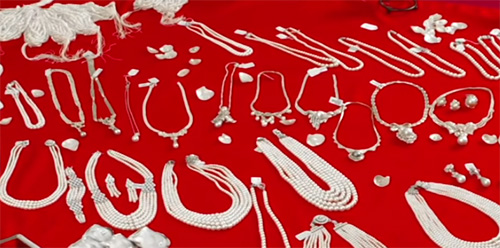
Pearls were rare and valuable and have been worn as a symbol of authority and social status through the ages. Myths and superstitious beliefs surrounded pearls, from embodying purity to bringing good luck in marriage or to symbolize tears and misfortune. The creation of the pearl associated with the birth of Aphrodite or Venus, the goddess of love and beauty, has made the pearl a symbol of seductiveness and femininity to the present day.
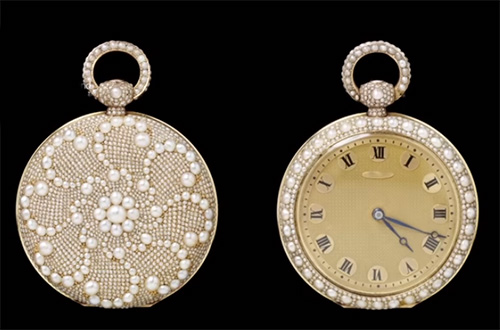
Watch, gold set with pearls, 1822-1838. Made in France or possibly Switzerland

Gold plated bronze pin, 2nd century B.C. Sanctuary of Aphrodite, Cyprus
Pearls in antiquity
In Roman times, pearls were desirable luxury. The Roman historian Pliny the Elder complained about the New Rich and their increasing fashion for pearls.

Mummy-portrait of an Egyptian woman. 100-200 A.D., Egypt
The most precious and valuable were often combined with emeralds.

Hair ornament. Gold, emeralds, sapphires, pearls. Roman Empire, 200-300 A.D.
Pliny claimed, “Women spend more money on their ears in pearl earrings than on any other part of their person”.
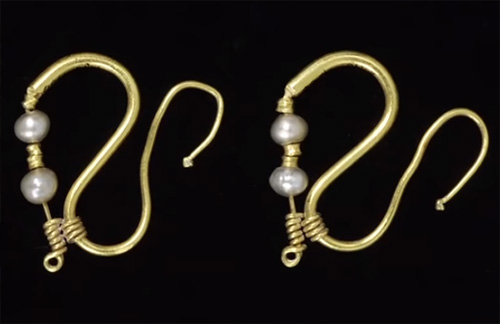
Pair of earrings. Gold, pearls. Roman Empire, 100-200 A.D.
The pearl as a Christian symbol
Christian symbols appeared in jewelry during the 5th century, when the Christian cross became fashionable. By the Middle Ages and in the Renaissance, pearls became symbolic of Christ. The creation of the pearl was associated with the Virgin Mary's miraculous conception of the Christ child. Its symbolism was of purity and perfection.

Pendant reliquary cross. Silver, silver gilt, ruby, sapphire, gamet, pearl. Germany, 1450-1475
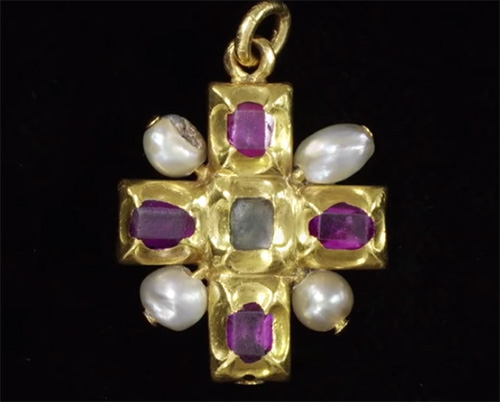
Cross pendant. Gold, rubies, pearls. Germany, 1500-1540
Renaissance era
Royals and nobles competed for large and beautiful pearls and wore them as a sign of political power and prosperity.
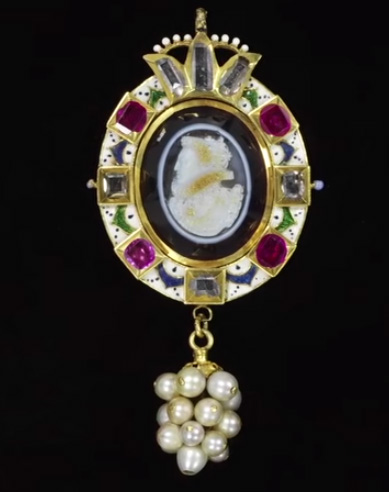
The Barbor Jewel. Gold, emerald, onyx cameo, rubies, diamonds, pearls. England, about 1615-1625
Catherine de Medici wore pearls in abundance as an expression of her status as queen. Her pearls, bequeathed to Mary, Queen of Scots, became a symbol of rivalry as they were sold by Mary's Scottish opponents to Elizabeth I.

Necklace of Mary, Queen of Scots. Gold, enamel, Scottish freshwater pearls. United Kingdom, about 1572
Baroque era
New dress fashions in pastel shades of satin were a perfect backdrop to pearls, worn in abundance, featured not only around the neck but also in bodice ornaments.

Bodice ornament. Gold filigree, freshwater pearls. Spain, about 1670
Queen Mary II wore her pearls draped across her decollete with a diamond.
Pearls symbolized virtuous femininity, marital fidelity, and fertility, often appearing in bridal portraits.
Pearls in sentimental jewelry
By the 18th and 19th centuries, pearls remained highly fashionable. They were often worn as chokers and conveyed deep-rooted and intimate messages of love and grief. Pearl jewelry was also associated with childhood, marriage, and death. Pearl decorative borders symbolized purity, innocence, or humility, while in mourning jewelry, pearls signified tears or sadness.

Lover’s Eye brooch. Gold, pearls, diamonds, painted miniature. England, 1800-1820
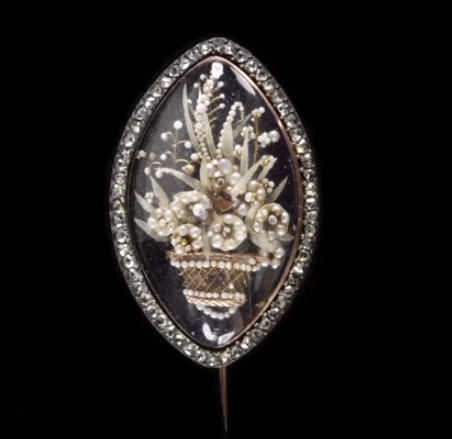
Brooch. Gold, pearls, hair, ivory, watercolor, gold foil. England or France, 1775-1800
Pearls in the 19th century
The 19th century was a period of aristocratic ostentation and grandeur. Queen Victoria and Empress Eugenie of France influenced international fashions and shared a passion for pearls in jewels.
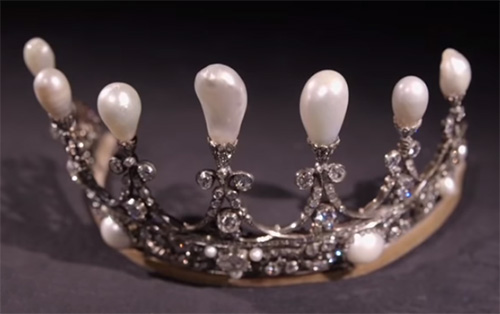
Hanover tiara. Gold, silver, pearls from the Pinctada maxima. Germany, about 1830
Magnificent tiaras of rare pearls and diamonds were worn by European aristocracy to dazzle and impress at sumptuous balls and grand occasions.
Pearls in the 1920s
The 1920s were characterized by informal dress codes and the lavish lifestyles of the elite. Pearl necklaces ranged from the modest choker to the long sautoirs hanging down to the waist. Styles were influenced by the exotic and by the modernist movement, which allowed women to apply makeup in public.

Sautoir. Platinum, carved emeralds, moonstone, diamonds, pearls. Paris, about 1925

Brooch. Gold, rock crystal, amethyst, pearls. Paris, 1937
Thus the vanity case became a fashionable accessory.
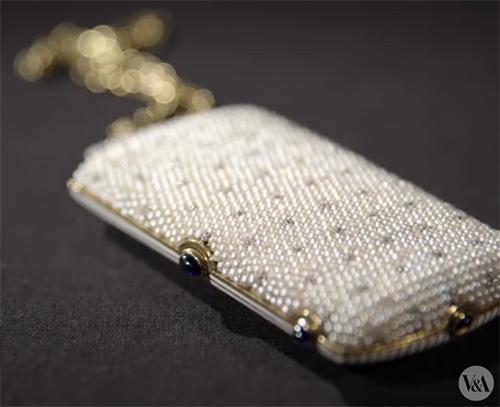
Vanity case. Gold, platinum, enamel, diamonds, sapphire, natural pearls. Western Europe, about 1915
Pearls in the East
In 18th- and 19th-century China and India, ostentatious displays of pearls formed an integral part of the regalia of ruling monarchs. In Europe, such opulence seemed unimaginable.

Pearl and bead decoration on an Imperial court robe. China, Qing dynasty (about 1870-1911)
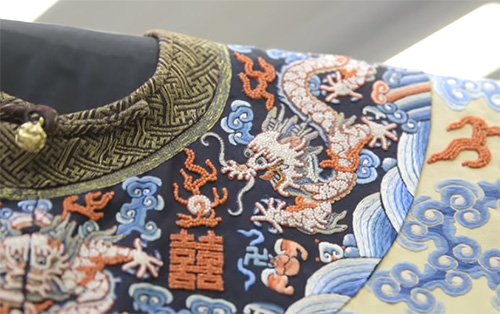
During this period, formal wear of the Indian and Nepalese courts was based on Western styles mixed with Eastern splendor. Elaborate pearl embroidery demonstrated the wealth of the owner.
Celebrity cult
In the 1930s, Coco Chanel promoted the fashion for pearls, as did the first lady Jackie Kennedy in the 1960s. And both combined cultured and imitation pearls. The screen goddesses of Hollywood movies upheld the glamour of pearls.

Ring belonging to Elizabeth Taylor. Platinum, diamonds, cultured pearl. Los Angeles, about 1960
Elizabeth Taylor preferred splendid jewels with natural pearls, while Marilyn Monroe wore a modest necklace of cultured pearls from Mikimoto on her private life.
The emergence of the cultural pearl
There had been several attempts to create pearls by human intervention. Kokichi Mikimoto remains the figure primarily associated with the invention and mass production of the cultured pearl. Mikimoto conquered the world markets, and his dream to adorn the necks of all women of the world with pearls became a reality.
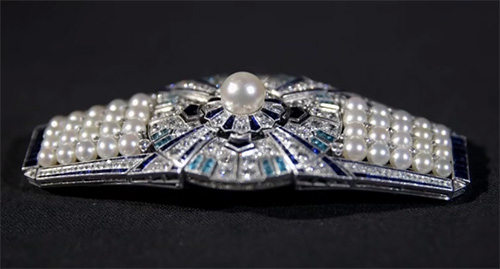
“Yaguruma” sash clip. Platinum, 18 carat white gold, cultured Akoya pearls, diamonds, sapphires, emeralds. Japan, 1937
Pearls today
Pearls are timeless jewels – the luster and beauty of them have been highly valued and continued to fascinate us.
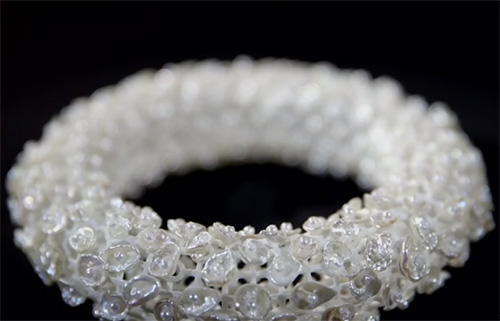
Snow white wrist piece “A Fusion of Winter Snow and Spring Flowers”. 3D-printed white plastic, cultured white pearls. London, 2012
It may seem as if everything has already been achieved using pearls – from the natural and cultured to simulated pearls. But it remains to be seen what the future will bring.

Necklace “Frozen”. Silver, cultured freshwater pearls, nylon threads. Germany, 2011
Today the aesthetics in pearl jewelry is boundless and the variety of pearls remarkable.
(c)


